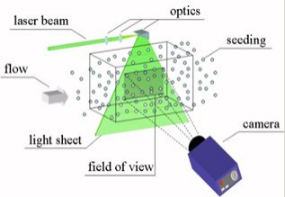Experimental topics
 Particle Image Velocimetry is a standardized measurement technique whereby flow velocities are estimated on the basis of recordings of scattered laser light from small particles injected in the flow (see right, Figure 1: Typical 2D PIV setup). In the image processing step, the consecutive images are divided into typically square areas, so-called interrogation or correlation windows. The relative displacement of the particle images between corresponding correlation windows is inferred through statistical estimators of which cross-correlation is the most common approach. Repeating this procedure for all the correlation windows yields the tracer velocity - and hence flow velocity - for the investigated field of view from which spatial flow structures can be deduced (see below, Figure 2: Vorticity contours behind a circular cylinder (Re≈2000) deduced from a PIV measurement).
Particle Image Velocimetry is a standardized measurement technique whereby flow velocities are estimated on the basis of recordings of scattered laser light from small particles injected in the flow (see right, Figure 1: Typical 2D PIV setup). In the image processing step, the consecutive images are divided into typically square areas, so-called interrogation or correlation windows. The relative displacement of the particle images between corresponding correlation windows is inferred through statistical estimators of which cross-correlation is the most common approach. Repeating this procedure for all the correlation windows yields the tracer velocity - and hence flow velocity - for the investigated field of view from which spatial flow structures can be deduced (see below, Figure 2: Vorticity contours behind a circular cylinder (Re≈2000) deduced from a PIV measurement).
 Despite being a very powerful and versatile measurement technique, PIV suffers from limitations inherent to the observed velocity and signal quality. When the velocity within a correlation window varies too strongly or there are not sufficient particle images within, the resulting vector may not be a good representation of the actual flow motion. It is often the experimentalist who needs to decide on the image interrogation parameters and even then, because the same settings are used throughout the image, they will never be optimal.
Despite being a very powerful and versatile measurement technique, PIV suffers from limitations inherent to the observed velocity and signal quality. When the velocity within a correlation window varies too strongly or there are not sufficient particle images within, the resulting vector may not be a good representation of the actual flow motion. It is often the experimentalist who needs to decide on the image interrogation parameters and even then, because the same settings are used throughout the image, they will never be optimal.
The group in Bristol continues the work on new image processing routines whereby the interrogation is automatically adapted to estimates of flow and signal content. The images below (Figure 3: (Left image) PIV snapshot of aircraft wake vortex (Right image) Predicted positions of correlation windows and sizes) show the example of a wake vortex. Through an iterative procedure location and size of the correlation windows are adjusted such as to maximize spatial resolution and robustness. As a result, the vicinity of the vortex core is densely sampled with smaller correlation windows whereas fewer, larger windows are located in the vortex periphery. By further adapting the process to the presence of interfaces, considerable improvements in performance have been obtained.

